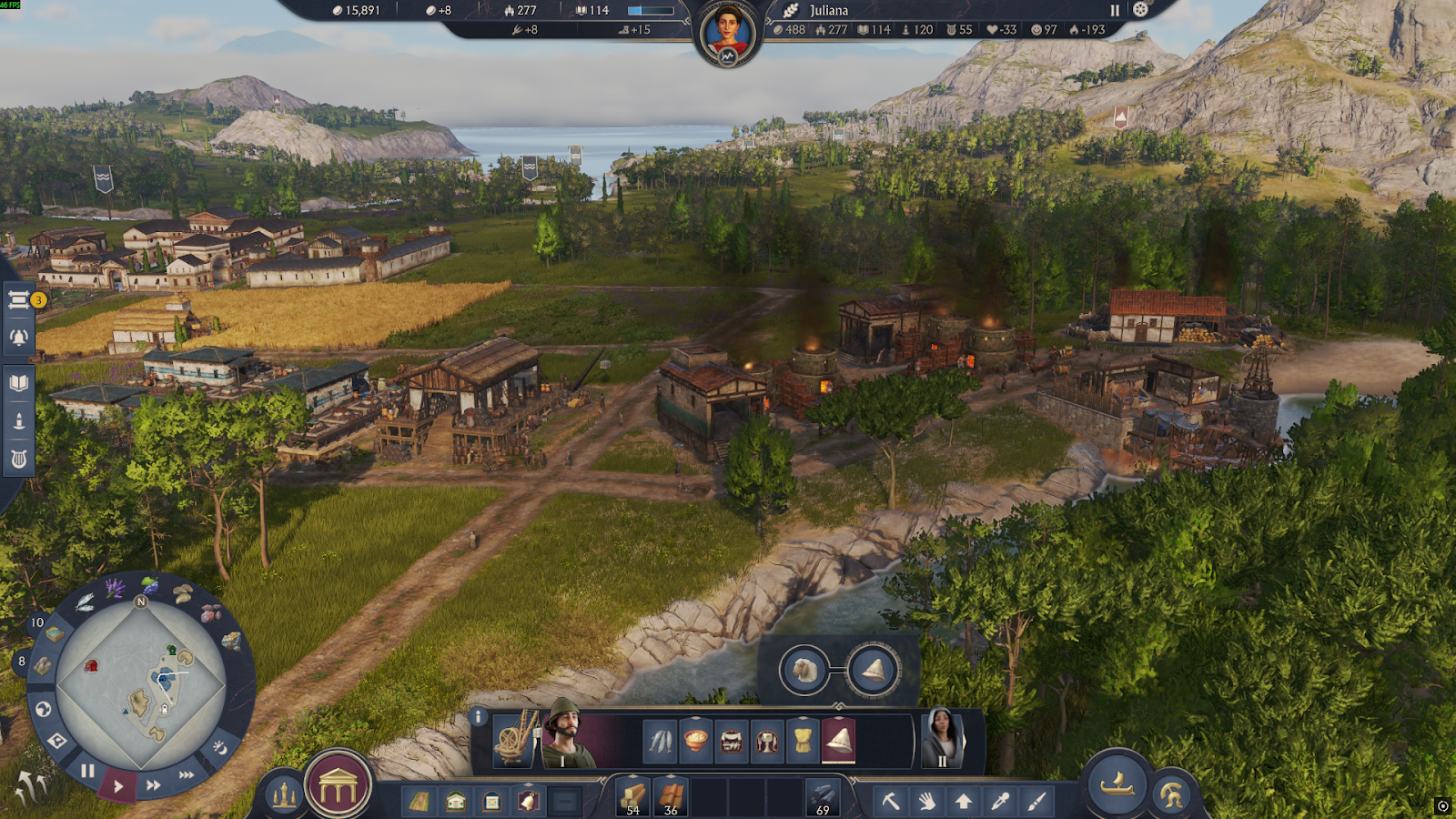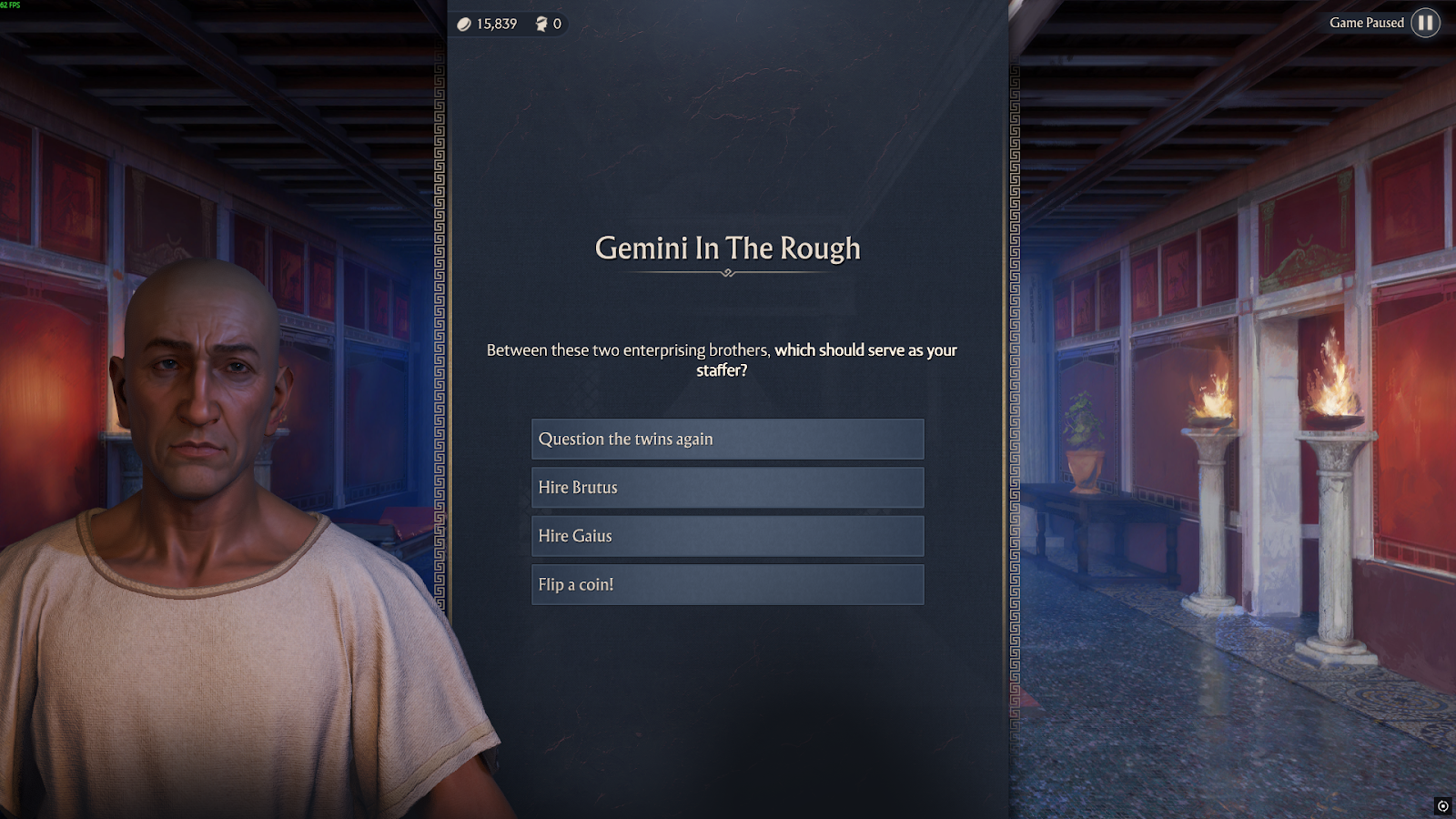You can trust VideoGamer. Our team of gaming experts spend hours testing and reviewing the latest games, to ensure you're reading the most comprehensive guide possible. Rest assured, all imagery and advice is unique and original. Check out how we test and review games here
In Anno 117 Pax Romana, your city lives and dies depending on how effectively and efficiently you can handle production chains (and some meddling from Rome). The crux of this elusive efficiency lies in production ratios, a rather confounding term that simply refers to the optimal number of production buildings required for a supply chain to run smoothly.
The overall benefit of having optimal production chains is that buildings don’t linger idle waiting for resources, and each one is working at peak efficiency consistently. This, in turn, means a steady flow of goods to sate your denizens and even partake in trade to stock up your coffers with Denarii. In this guide, we’ll walk you through the optimal production ratios for each supply chain in Anno 117 Pax Romana.
- Production ratios ensure supply chains run at peak efficiency.
- The key is to have the right number of building of each type to ensure there’s no time or surplus materials being produced.
- Ratios differ between Latium and Albion.
Production ratios explained

Put simply, production ratio is the optimal number of buildings of different types in a supply chain to ensure none of them are missing resources and there isn’t a raw material surplus at any time. This ensures the final product in the chain is produced as fast and as efficiently as possible with no downtime. The idea is to consider the processing time of each building to determine the optimal number of each required.
An example is the best way to explain production ratios. A Sheep Farm takes 30 seconds to produce 1t of Sheep, while Pileus Felter takes 60 seconds to produce 1t of Pileus from 1t of Sheep. What this means is that for every 1t of Pileus you produce, you’ll have a surplus of 1t of Sheep. To optimise the Pileus production chain, you’ll want two Pileus Felters using 2t of Sheep to produce 2t of Pileus every 60 seconds. The 1t of Sheep produced every 30 seconds (or 2t every 60 seconds) by the Sheep Farm is therefore used.
It also works the other way around, where not enough of a raw material is produced to keep up with the production time of buildings further down the supply chain. In other words, ratios let all the buildings in a supply chain keep up with one another’s processing time.
Note that this assumes that you’ve attained and maintained 100% perfect productivity for each building. These ratios are also affected by Specialist buffs and perks as well as research benefits, but as these are so varied and player-dependent, we won’t factor them in here.
Anno 117 Pax Romana Production ratios

Here are the production buildings for all buildings on both the Latium and Albion maps:
| Needs/Goods | Latium Production Ratio | Albion Production Ratio |
|---|---|---|
| Timber | x1 Woodcutter, x1 Sawmill | x1 Woodcutter, x1 Sawmill |
| Porridge | x1 Oats Farm, x1 Porridge Stand | n/a |
| Tunic | x1 Hemp Farm, x1 Spinner | x1 Hemp Farm, x1 Spinner |
| Pileus | x1 Sheep Farm, x2 Pileus Felter | n/a |
| Tiles | x1 Clay Pit, x1 Charcoal Burner, x2 Tilers | x1 Charcoal Burner, x3 Mud Driers, x2 Tilers |
| Bread | x2 Wheat Farms, x1 Grain Mill, x1 Charcoal Burner, x2 Bakeries | n/a |
| Garum | x1 Salt Ponds, x2 Scomber’s Shack, x3 Garum Works | n/a |
| Sandals | x1 Pig Farm, x11 Salt Ponds, x2 Tanneries, x4 Sandal Makers | n/a |
| Soap | x1 Pig Farm, x1 Charcoal Burner, x2 Renderers, x4 Lavender Growers, x2 Soap Makers | n/a |
| Amphorae | x1 Clay Pit, x2 Resin Tappers, x1 Charcoal Burner, x2 Potters | x3 Mud Driers, x2 Resin Tapper, x1 Charcoal Burner, x2 Potter |
| Olive Oil | x4 Olive Growers, x3 Olive Presses | n/a |
| Concrete | x2 Limestone Quarries, x3 Sand Refineries, x6 Concrete Mixers | x2 Limestone Quarries, x3 Sand Refineries, x6 Concrete Mixers |
| Wine | x2 Vineyards, x1 Apiary, x1 Vintner | x4 Vineyards, x1 Apiary, x1 Vintner |
| Togas | x3 Flax Farms, x3 Snaileries, x4 Weavers, x4 Dye Works, x2 Loom Weaveries | n/a |
| Writing Tablets | x3 Apiaries, x6 Sandarac Nurseries, x8 Tabuli | n/a |
| Fine glass | x3 Mineral Quarries, x3 Sand Refineries, x4 Mineral Crushers, x6 Glass Smelters, x4 Charcoal Burners, x8 Glassblowers | n/a |
| Marble | x2 Marble Quarries, x3 Marble Masons | n/a |
| Mosaics | x2 Clay Pit, x3 Mineral Quarry, x4 Mineral Crusher, x9 Tessera Works | n/a |
| Oysters with Caviar | x3 Oyster Bed, x4 Sturgeon Hatchery, x3 Fish Gutter, x2 Epicure of Water | n/a |
| Loungers | x3 Apiaries, x6 Sandarac Nurseries, x8 Tabuli | n/a |
| Necklaces | x4 Gold Washers, x1 Goldsmiths, x1 Mineral Quarry, x1 Charcoal Burners, x2 Jewellers | n/a |
| Lyres | x4 Gold Washers, x1 Sheep Farm, x2 Stringers, x2 Sandarac Nurseries, x1 Goldsmith, x1 Charcoal Burner, x1 Gilder, x1 Lythier | n/a |
| Armor | x1 Iron Mine, x2 Furnace, x1 Pig Farm, x1 Salt Ponds, x2 Tannery, x3 Armorer | x1 Iron Mine, x2 Furnace, x1 Pig Farm, x1 Salt Ponds, x2 Tannery, x3 Armorer |
| Weapons | x1 Iron Mine, x2 Furnace, x3 Weaponsmith | x1 Iron Mine, x2 Furnace, x3 Weaponsmith |
| Ropes | x1 Hemp Farm, x2 Ropemaker | x1 Hemp Farm, x2 Ropemaker |
| Sails | x1 Sheep Farm, x3 Sailmakers | x1 Sheep Farm, x3 Sailmakers |
| Reed Shoes | n/a | x1 Reed Gatherer, x2 Shoe Weaver |
| Wattle & Daub | n/a | x3 Mud Driers, x2 Reed Gatherers, x2 Labourer’s Yards |
| Cheese | n/a | x1 Ochs Farm, x2 Dairies |
| Beer | n/a | x2 Barley Farms, x1 Malthouse, x2 Brewries, x1 Charcoal Burner |
| Roast Beef | n/a | x2 Ochs Farms, x1 Charcoal Burner, x3 Saltwort Pickers, x4 Earth Ovens |
| Trousers | n/a | x1 Sheep Farm, x2 Weld Crops, x3 Hosiers |
| Torcs | n/a | x1 Copper Mine, x3 Wire Twisters, x1 Charcoal Burner |
| Clan Shields | n/a | x2 Weld Crop, x1 Tin Mine, x1 Copper Mine, x2 Bronze Smelter, x3 Shieldbeater |
| Drinking Horns | n/a | x1 Tin Mine, x2 Ochs Farm, x4 Horners |
| Granite | n/a | x3 Granite Quarries, x 8 Granite Cutters |
| Fur Hats | n/a | x3 Saltwort Pickers, x2 Saltwort Burners, x1 Charcoal Burner, x3 Beaver Trappers, x4 Beaver Hatters |
| Bird Tongues in Aspic | n/a | x3 Bird Charmers, x1 Pig Farm, x1 Charcoal Burner, x2 Renderers, x4 Tongue Pluckers, x3 Epicures of Air |
| Sausages | n/a | x1 Pig Farm, x3 Herb Garden, x2 Salsicium |
| Brooches | n/a | x1 Silver Mine, x2 Silver Forge, x2 Charcoal Burners, x4 Fibularium |
| Cloaks | n/a | x2 Weld Crops, x1 Copper Mine, x1 Sheep Farm, x3 Greenhands, x2 Birrus Stitchers |
| Handmirrors | n/a | x1 Silver Mine, x2 Silver Forges, x2 Charcoal Burners, x3 Shell Gatherers, x4 Narcissiums |
| Chariots | n/a | x1 Woodcutter, x2 Reed Gatherers, x3 Chassis Builders, x2 Horsecatchers, x4 Chariot Workshops |
| Wigs | n/a | x4 Horse Breeder, x3 Flax Farm, x2 Resin Trapper, x4 Headpiece Maker, x3 Wig Maker |
FAQs
Production ratios in Anno 117 Pax Romana adjust the number of buildings needed to complete a supply based on their respective processing time to ensure maximum efficiency.
To attain 100% perfect productivity in Anno 117 Pax Romana, ensure your building has access to all the natural resources it requires and a sufficient workforce.
No, but it does ensure your city in Anno 117 Pax Romana is operating at maximum efficiency with no surplus resources or idle production buildings.







